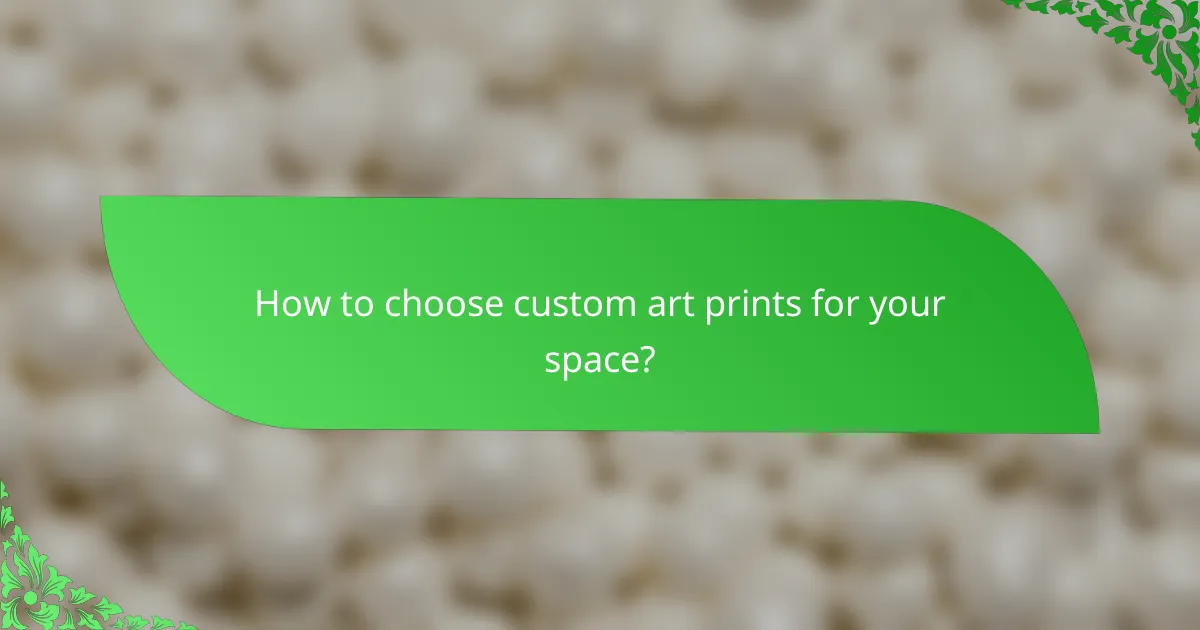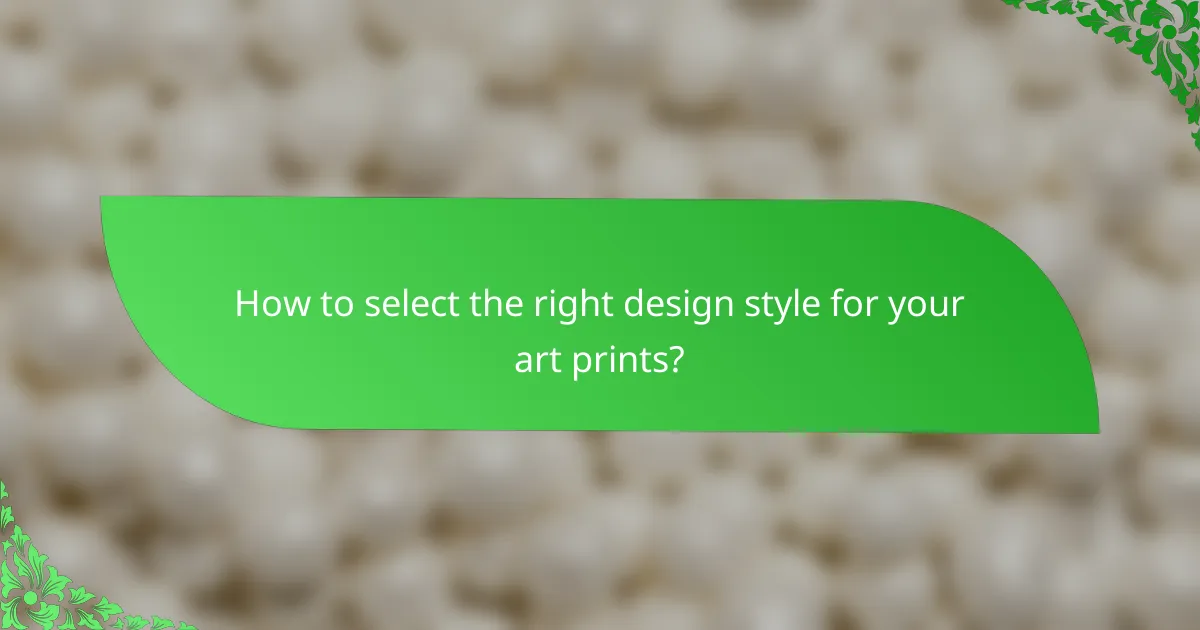Custom art prints provide a unique opportunity to tailor artwork to your specific space, ensuring a perfect fit that enhances your decor. By taking into account your wall dimensions, color schemes, and lighting, you can select pieces that not only complement your environment but also reflect your personal style. Accurate measurements are essential for achieving a harmonious look that elevates your space without overwhelming it.

How to choose custom art prints for your space?
Choosing custom art prints for your space involves understanding your wall dimensions, existing decor, color schemes, and lighting conditions. By carefully considering these factors, you can select prints that enhance your environment and reflect your personal style.
Consider wall dimensions
Start by measuring your wall space to determine the appropriate size for your art prints. A general rule is to leave some empty space around the artwork; aim for at least 10-15% of the wall’s width as a margin. For larger walls, consider creating a gallery wall with multiple smaller prints to fill the area effectively.
For example, if your wall is 3 meters wide, a single print should ideally be around 60-90 cm wide. If opting for a gallery wall, arrange prints in a cohesive layout that complements the overall dimensions.
Evaluate existing decor
Your current decor plays a crucial role in selecting art prints. Take note of the furniture, colors, and styles already present in the room. Choose prints that either harmonize with or provide a striking contrast to your decor to create visual interest.
For instance, if your room features modern furniture, contemporary art prints can enhance the aesthetic. Conversely, traditional prints can add a classic touch to a more eclectic or vintage setting.
Determine color schemes
Color schemes are vital when choosing art prints. Analyze the dominant colors in your space and select prints that either match or complement these hues. This will create a cohesive look and enhance the overall ambiance.
Consider using a color wheel to identify complementary colors or analogous shades. For example, if your room has warm tones like reds and oranges, art prints featuring similar warm colors or contrasting cool tones can create a balanced feel.
Assess lighting conditions
Lighting significantly affects how art prints are perceived in a space. Natural light can enhance colors, while artificial lighting may create shadows or alter hues. Assess the lighting conditions throughout the day to determine how your chosen prints will look at different times.
For areas with bright natural light, consider using UV-protective glass to prevent fading. In dimly lit spaces, opt for prints with vibrant colors or metallic finishes that can catch light and draw attention.

What are the benefits of custom-sized art prints?
Custom-sized art prints offer the advantage of perfectly fitting your unique space, enhancing the overall aesthetic of your environment. They allow for greater flexibility in design, ensuring that the artwork complements your decor and personal style.
Perfect fit for any space
Custom-sized art prints are tailored to fit specific dimensions, making them ideal for any area, whether it’s a small nook or a large wall. This ensures that the artwork does not overwhelm or underwhelm the space, creating a harmonious balance.
When considering a custom size, measure your wall or designated area carefully. For instance, if you have a 60-inch wide wall, a print that is 48 inches wide can create a striking focal point while leaving space for other decor.
Enhanced visual appeal
Art prints that are custom-sized can significantly enhance the visual appeal of a room. By choosing dimensions that align with your furniture and layout, the artwork can draw attention and create a cohesive look.
For example, a panoramic print can work beautifully above a sofa, while a series of smaller prints can be arranged in a grid format to fill a larger wall. This thoughtful arrangement can elevate the overall aesthetic of your space.
Personalized design options
Custom-sized art prints provide the opportunity for personalized design options, allowing you to select images, colors, and styles that resonate with your taste. This level of customization ensures that the artwork reflects your personality and complements your home decor.
Consider incorporating elements like your favorite colors or themes that resonate with you. Whether you prefer abstract designs or nature scenes, the ability to customize size and design means your art will be truly unique.

How to measure for custom art prints?
Measuring for custom art prints involves determining the exact dimensions needed to fit your space while considering design elements. Accurate measurements ensure that your art prints enhance your environment without overwhelming it.
Use a measuring tape
To start, use a measuring tape to obtain precise dimensions of the area where you plan to display the art print. Measure the width and height of the wall or space, noting any obstructions like furniture or windows that may affect placement.
When measuring, it’s helpful to take multiple measurements at different points to ensure accuracy, especially in older homes where walls may not be perfectly straight. Record your measurements in inches or centimeters, depending on your preference.
Consider frame dimensions
When selecting custom art prints, consider the dimensions of the frame you intend to use. The frame adds to the overall size of the artwork, so ensure that the combined dimensions fit well within your designated space.
Standard frame sizes often range from 8×10 inches to 24×36 inches, but custom frames can be made to any size. Keep in mind that a larger frame may require more wall space and could impact the visual balance of the room.
Account for spacing
Spacing around your art print is crucial for achieving a polished look. Leave enough room between the print and surrounding elements, such as furniture or other artwork, to avoid a cluttered appearance.
A good rule of thumb is to allow at least 2-4 inches of space around smaller prints and more for larger pieces. Consider the overall layout of the room and how the art print will interact with other design elements to create a harmonious aesthetic.

What types of materials are available for art prints?
Art prints can be created using various materials, each offering distinct aesthetics and durability. The most common options include canvas, paper, and metal, each catering to different tastes and display environments.
Canvas prints
Canvas prints are made from high-quality fabric stretched over a wooden frame, providing a textured and artistic appearance. They are ideal for larger artworks and can enhance the depth of colors, making them suitable for both modern and classic decor.
When considering canvas prints, think about the weight and thickness of the canvas, as well as the type of ink used for printing. Canvas prints are often more durable and can be displayed without glass, reducing glare and reflections.
Paper prints
Paper prints are produced on various types of paper, including glossy, matte, and fine art paper. This material is versatile and can reproduce intricate details and vibrant colors, making it a popular choice for photography and detailed artwork.
When selecting paper prints, consider the weight of the paper, which typically ranges from 180 to 300 gsm. Heavier papers are often more durable and provide a premium feel, while lighter options may be more affordable and suitable for casual displays.
Metal prints
Metal prints are created by infusing dyes directly onto aluminum sheets, resulting in a sleek and modern look. They are highly durable, resistant to fading, and can be displayed in various environments, including kitchens and outdoor spaces.
For metal prints, consider the thickness of the aluminum and the finish, which can be glossy or matte. These prints are often lightweight and easy to hang, making them a practical choice for contemporary art displays.

How to select the right design style for your art prints?
Selecting the right design style for your art prints involves understanding your personal preferences and the aesthetic you want to achieve in your space. Consider factors like color schemes, themes, and the overall vibe of your environment to ensure your art complements your decor.
Identify personal taste
Your personal taste is the foundation of selecting art prints. Reflect on what styles resonate with you, whether it’s modern, abstract, classic, or minimalist. Consider creating a mood board with images that inspire you to visualize your preferences.
Think about the colors and themes that you are drawn to. For instance, if you love nature, landscapes or botanical prints might be ideal. If you prefer bold statements, look for vibrant abstract pieces.
Research current trends
Staying updated on current art trends can help refine your choices. Trends often shift towards specific styles, colors, or themes that resonate with broader audiences. Websites, social media platforms, and art exhibitions are great resources for discovering what’s popular.
For example, earthy tones and sustainable art practices have gained traction recently. Incorporating these elements can make your art selections feel contemporary and relevant.
Explore local artists
Supporting local artists not only enriches your collection but also connects you with your community. Visit local galleries, art fairs, or online platforms that showcase regional talent. This exploration can lead to unique pieces that reflect your area’s culture and aesthetics.
Engaging with local artists can also provide insights into their creative processes, which may deepen your appreciation for the artwork. Consider hosting an art night or visiting open studios to discover new styles and inspirations directly from the creators.

What are the best practices for hanging art prints?
To hang art prints effectively, consider the weight, size, and style of the prints, as well as the space in which they will be displayed. Proper techniques ensure that the artwork is secure, visually appealing, and enhances the overall aesthetic of the room.
Use appropriate hardware
Selecting the right hardware is crucial for securely hanging art prints. Use wall anchors for heavier pieces and ensure that the hooks or nails can support the weight of the artwork. For larger prints, consider using multiple points of support to distribute the weight evenly.
Common hardware options include picture hooks, D-rings, and adhesive strips. Always check the weight limits of the hardware to avoid accidents or damage to your walls.
Follow height guidelines
When hanging art prints, aim for the center of the artwork to be at eye level, which is typically around 57 to 60 inches from the floor. This height allows for optimal viewing and creates a balanced look in the space.
For groupings of art, maintain consistent spacing between pieces, usually around 2 to 5 inches apart. This approach creates a cohesive display and draws attention to the collection as a whole.
